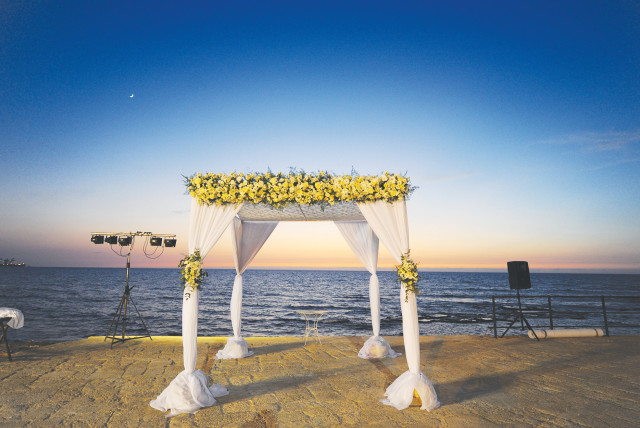Can Judaism find a loving approach to include interfaith families? - opinion

A thoughtful and sensitive approach to intermarriage would adopt a live-and-let-live attitude by which those who identify as Jewish could be considered Jewish for all purposes.
Is it too much to hope that the Institute for Jewish Policy Research (IJPR) report on the worldwide prevalence of interfaith marriage will lead to more positive attitudes regarding inclusion of interfaith families?
If The Jerusalem Post’s excellent editorial “Tackling intermarriage” (August 3) is an indicator, Jewish thought leaders might finally be coming to the realization that interfaith marriage is not only “a significant phenomenon that cannot be ignored” but more importantly that it must “be approached thoughtfully and sensitively.”
That would be a refreshing change from the past 25 years, when most commentary coming out of Israel and the traditional Jewish community condemned interfaith marriage as inevitably leading to loss of Jewish identity and connection. As recently as March, Thomas Friedman reported in The New York Times that Israel’s government viewed liberal American Jews “as a dying breed, intermarrying their way to irrelevance.”
Now, instead, the Post’s editors applaud “creative approaches to intermarriage” that take into account “contemporary reality, traditional understandings of Halacha [Jewish law], the feelings of both Jewish and non-Jewish spouses, and the need to safeguard the future of the Jewish people.”
It would be an extremely welcome and productive development if that attitude became more widespread.
The “contemporary reality” that the editors ask be taken into account, in North America at least, is that interfaith marriage is an inexorable reality among non-Orthodox Jews. While the IJPR report pegs the percentage of intermarried American Jews at 45%, the editorial aptly notes the higher 65% rate among 18 to 29-year-olds. None of the programmatic efforts to strengthen Jewish identity – day schools, camps, Birthright Israel – have succeeded in significantly preventing interfaith marriage to the extent that was their goal.
Conversion is a wonderful personal choice, and some “exploring Judaism” programs lead to many conversions. However, promoting conversion has never significantly reduced the incidence of intermarriage. The report notes that there is less intermarriage where there is more traditionalism. It asks, “Can anything be done to increase the volume of traditionalism?” In North America, at least, the answer is, not in a way that would meaningfully impact interfaith marriage among liberal Jews.
Engaging interfaith couples is essential for the future of the Jewish people
Given the reality of interfaith marriage, engaging more interfaith couples in Jewish communal life is essential to “safeguarding the future of the Jewish people.” The IJPR report correctly notes that on typical measures, interfaith families are less Jewishly engaged. But some significant number of interfaith families have always engaged, as I wrote in “What Israelis need to know about intermarriage in North America,” published in the Post in 2009. The key question, therefore, is: What can be done that will lead to more Jewish engagement among interfaith families?
THE POST editorial hit the nail on the head when it said that “the feelings of both Jewish and non-Jewish spouses” must be taken into account. As I have explained elsewhere, in North America there is a growing consensus that people will engage in a community or organization if they feel not just welcomed – that their presence is appreciated – but also included, that they belong.
Interfaith couples won’t feel that they belong in Jewish groups if the Jewish partner is regarded as a norm-violator and the partner is seen as undesirable or sub-optimal. That’s why the editorial is so important; it’s so different from the message interfaith couples receive from all parts of the Jewish world that denigrates interfaith marriage.
Considering interfaith couples as equal to same-faith couples is of course a challenge to traditional understandings of Halacha. Even more so is treating patrilineal Jews, as well as Jewishly engaged but unconverted partners from different faith backgrounds, as equal, and allowing them to participate fully in Jewish ritual.
When traditional Jews condemn liberal Jews’ inclusion of patrilineal Jews and unconverted partners as violating Jewish law, the messaging pushes interfaith couples away from Jewish engagement. A thoughtful and sensitive approach to intermarriage would adopt a live-and-let-live attitude by which those who identify as Jewish could be considered Jewish for all purposes where halachic status is not essential. Where status according to Jewish law is essential, it can be addressed – a non-halachic Jew could chose to convert under auspices acceptable to their prospective partner.
Recent efforts – like President Herzog’s Kol Ha’am, and Global Jewry – seek to build unity among Jews in Israel and in the Diaspora, a laudable goal. But they never talk about uniting with the many interfaith couples and partners from different faith backgrounds who are participating in Jewish communities. There’s a prevailing tone-deafness to their pervasive presence in the North American Jewish community – which needs to be inclusive of them in order to be strengthened.
The IJPR’s executive director, commenting on the report in the Post, said that in the month of Av, “We’re called on to choose between love and hate across our differences. Choose the former, and we may achieve something together.” A loving approach to interfaith couples and partners from different faith backgrounds – is that too much to hope for?
The writer, the retired founder of InterfaithFamily (now 18Doors), is president of the Center for Radically Inclusive Judaism and author of Radical Inclusion: Engaging Interfaith Families for a Thriving Jewish Future and A New Theory of Interfaith Marriage.
Jerusalem Post Store
`; document.getElementById("linkPremium").innerHTML = cont; var divWithLink = document.getElementById("premium-link"); if (divWithLink !== null && divWithLink !== 'undefined') { divWithLink.style.border = "solid 1px #cb0f3e"; divWithLink.style.textAlign = "center"; divWithLink.style.marginBottom = "15px"; divWithLink.style.marginTop = "15px"; divWithLink.style.width = "100%"; divWithLink.style.backgroundColor = "#122952"; divWithLink.style.color = "#ffffff"; divWithLink.style.lineHeight = "1.5"; } } (function (v, i) { });

